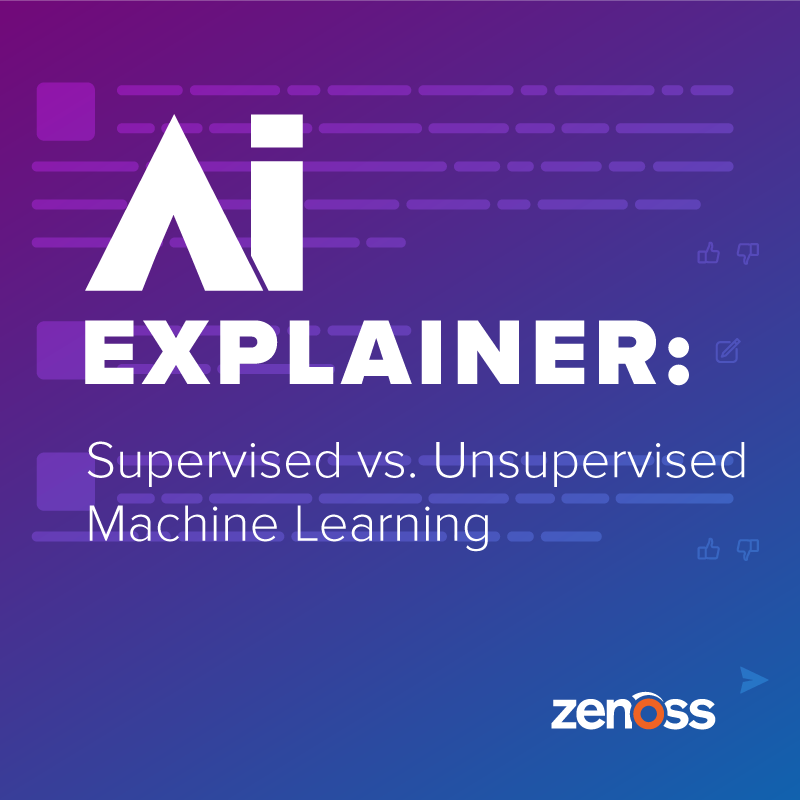Machine learning is a powerful tool that enables computers to learn from data and make predictions or decisions without being explicitly programmed. Two fundamental approaches to machine learning are supervised and unsupervised learning. In this blog post, we'll explore the key differences between these two approaches, along with examples of their applications.
Supervised Machine Learning
In supervised learning, the algorithm is trained on a labeled dataset, where each input data point is associated with a corresponding output label. The goal is to learn a mapping function from the input variables to the output variable, based on the labeled examples provided during training. Supervised learning is used for tasks where the desired output is known and can be explicitly provided. Here are some example real-world applications:
- Classification: Predicting whether an email is spam or not spam. In email communication, spam emails pose a significant problem, clogging inboxes with unwanted messages and potentially malicious content. Supervised learning algorithms, such as support vector machines or decision trees, can be trained on labeled email datasets, where each email is labeled as either spam or not spam. By analyzing the content, sender information, and other features of incoming emails, the trained classifier can accurately predict whether a new email is spam or legitimate. Email service providers use these classifiers to automatically filter out spam emails, protecting users from unwanted messages and potential security threats.
- Regression: Predicting the sales price of a house based on its features. In the real estate market, accurately predicting house prices is crucial for buyers, sellers and real estate agents alike. Supervised learning regression models, such as linear regression or gradient-boosting regressors, can be trained on historical housing data, including features such as square footage, number of bedrooms, location and amenities, along with their corresponding sale prices. By learning the relationships between these features and house prices, the regression model can predict the selling price of a new property based on its characteristics. Real estate professionals use these predictions to set competitive listing prices, negotiate offers, and make informed investment decisions.
- Object Detection: Monitoring retail shelves. In retail environments, ensuring product availability and proper shelf organization is critical for maximizing sales and enhancing the customer shopping experience. Retailers often use object detection systems to monitor shelves and identify products that are out of stock, misplaced or incorrectly priced. Supervised learning object detection models, trained on labeled images of store shelves, can detect individual products and their positions within the shelves. By analyzing images captured by in-store cameras or drones, the object detection system can identify instances where shelves need restocking, products need rearranging, or pricing labels need adjustment. This technology helps retailers optimize inventory management, maintain store cleanliness, and improve overall customer satisfaction.
Unsupervised Machine Learning
In unsupervised learning, the algorithm is trained on an unlabeled dataset, where the input data points are not associated with any corresponding output labels. The goal is to discover hidden patterns, structures, or relationships within the data without explicit guidance. Unsupervised learning is used for tasks where the underlying structure of the data is unknown or where labeled data is scarce. Here are some example real-world applications:
- Clustering: In the retail industry, businesses often collect data on customer transactions, including purchase history, demographics and preferences. By applying clustering algorithms to this data, such as k-means clustering or hierarchical clustering (grouping similar data points together based on their characteristics), retailers can identify distinct customer segments based on their purchasing behavior. For instance, one segment might consist of budget-conscious shoppers who frequently purchase discounted items, while another segment might comprise high-value customers who prefer premium products. Understanding these customer segments allows retailers to tailor marketing strategies, product offerings and pricing strategies to better meet the needs and preferences of each segment.
- Dimensionality Reduction: In image processing, high-resolution images often contain a vast amount of redundant or irrelevant information, leading to large file sizes and increased storage and transmission costs. Dimensionality reduction techniques, such as principal component analysis or autoencoders, can be used to compress images by capturing the most essential features while discarding less important details. By reducing the dimensionality of images while preserving their essential information, dimensionality reduction techniques enable more efficient storage and transmission of images, making them ideal for applications such as online photo sharing platforms, video streaming services, and satellite imaging.
- Anomaly Detection: In the financial sector, detecting fraudulent activities, such as credit card fraud or money laundering, is a critical challenge. Anomaly detection techniques, such as Isolation Forest or Gaussian mixture models, which identify unusual or unexpected patterns in data that deviate from normal behavior, can be applied to analyze patterns in financial transactions and identify unusual or suspicious behavior that deviates from normal activity. For example, anomalies may include unusually large transactions, transactions occurring at unusual times or locations, or patterns inconsistent with a customer's typical spending behavior. By automatically flagging potential anomalies for further investigation, anomaly detection systems help financial institutions prevent fraudulent transactions, protect customer accounts, and mitigate financial losses.
In summary, supervised and unsupervised learning are two fundamental approaches in machine learning, each suited to different types of tasks and datasets. Supervised learning relies on labeled data to make predictions or classifications, while unsupervised learning uncovers hidden patterns or structures within unlabeled data. By understanding the differences between these approaches and their respective applications, practitioners can choose the most appropriate technique for their specific machine learning tasks.
If you want to see some of the cool things we’re doing with AI at Zenoss, click here.










